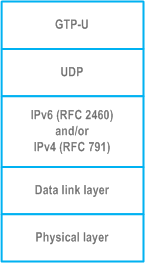TS 38.424
NG-RAN — Xn interface –
Data Transport
V18.0.0 (PDF)
2024/03 10 p.
V17.0.0
2022/03 10 p.
V16.0.0
2020/06 10 p.
V15.2.0
2019/06 10 p.
- Rapporteur:
- Mr. Miller, James
InterDigital Germany GmbH
Content for TS 38.424 Word version: 18.0.0
1 Scope p. 5
The present document specifies the standards for user data transport protocols and related signalling protocols to establish user plane transport bearers over the Xn interface.
2 References p. 5
The following documents contain provisions which, through reference in this text, constitute provisions of the present document.
- References are either specific (identified by date of publication, edition number, version number, etc.) or non specific.
- For a specific reference, subsequent revisions do not apply.
- For a non-specific reference, the latest version applies. In the case of a reference to a 3GPP document (including a GSM document), a non-specific reference implicitly refers to the latest version of that document in the same Release as the present document.
[1]
TR 21.905: "Vocabulary for 3GPP Specifications".
[2]
TS 29.281: "General Packet Radio System (GPRS) Tunnelling Protocol User Plane (GTPv1-U)".
[3]
RFC 768 (1980-08): "User Datagram Protocol".
[4]
RFC 2474 (1998-12): "Definition of the Differentiated Services Field (DS Field) in the Ipv4 and Ipv6 Headers".
[5]
RFC 8200 (2017-07): "Internet Protocol, Version 6 (IPv6) Specification".
[6]
RFC 791 (1981-09): "Internet Protocol".
[7]
TS 38.300: "NR; NR and NG-RAN Overall Description; Stage 2".
3 Definitions and abbreviations p. 5
3.1 Definitions p. 5
For the purposes of the present document, the following terms and definitions below apply. Terms and definitions not defined below can be found in TR 21.905.
NG-RAN node:
as defined in TS 38.300.
3.2 Abbreviations p. 5
For the purposes of the present document, the abbreviations given in TR 21.905 and the following apply. An abbreviation defined in the present document takes precedence over the definition of the same abbreviation, if any, in TR 21.905.
GTP
GPRS Tunnelling Protocol
IP
Internet Protocol
TEID
Tunnel Endpoint Identifier
UDP
User Datagram Protocol
4 Data link layer p. 6
Any data link protocol that fulfils the requirements toward the upper layer may be used.
5 Xn interface user plane protocol p. 6
5.1 General p. 6
The transport layer for data streams over Xn is an IP based Transport. The following Figure shows the transport protocol stacks over Xn.

The GTP-U (TS 29.281) protocol over UDP over IP shall be supported as the transport for data streams on the Xn interface. The data link layer is as specified in clause 4.
The transport bearer is identified by the GTP-U TEID (TS 29.281) and the IP address (source TEID, destination TEID, source IP address, destination IP address).
5.2 GTP-U p. 6
The GTP-U (TS 29.281) protocol shall be used over the Xn interface between two NG-RAN nodes.
5.3 UDP/IP p. 6
The path protocol used shall be UDP (IETF RFC 768).
The UDP port number for GTP-U shall be as defined in TS 29.281.
The NG-RAN nodes over the Xn interface shall support fragmentation and assembly of GTP packets at the IP layer.
The NG-RAN nodes shall support IPv6 (IETF RFC 8200) and/or IPv4 (IETF RFC 791).
There may be one or several IP addresses in both NG-RAN nodes. The packet processing function in the source NG-RAN node shall send downstream packets of a given flow to the target NG-RAN node IP address (received in XnAP) associated to the DL transport bearer of that particular flow. The packet processing function in the source NG-RAN node shall send upstream packets of a given flow to the target NG-RAN node IP address (received in XnAP) associated to the UL transport bearer of that particular flow.
The Transport Layer Address signalled in XnAP messages is a bit string of:
5.4 DiffServ code point marking p. 7
IP Differentiated Services code point marking (IETF RFC 2474) shall be supported. The mapping between traffic categories and DiffServ code points shall be configurable by O&M based on 5G QoS Class Identifier (5QI) , the Priority Level (if explicitly signalled), and other NG-RAN traffic parameters (e.g. ARP). Traffic categories are implementation-specific and may be determined from the application parameters.